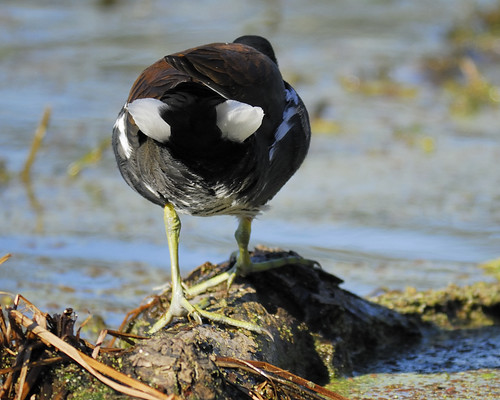tags: Common Moorhen, Gallinula chloropus, birds, mystery bird, bird ID quiz
[Mystery bird] Common Moorhen, Gallinula chloropus, photographed at Brazos Bend State Park, Needville, Texas. [I will identify this bird for you in 48 hours]
Image: Joseph Kennedy, 27 December 2009 [larger view].
Nikon D200, Kowa 883 telescope with TSN-PZ camera eyepiece 1/500s f/8.0 at 1000.0mm iso400.
Please name at least one field mark that supports your identification.


Common Moorhen?
Big chickeny looking feet and bare legs took me to the shorebirds. It seems more chunky than a heron or bittern would be.
The white tail bit and stripe on the flank made me think common moorhen (when I looked in my book).
In the absence of any actual classical language knowledge, I will say that that is a "cute little chicken with colorful, um, pus."
Hey John,
I can't actually see the photo during the day because the District of Columbia goverment server blocks sites such as Flickr where Grrl has her photos "hosted", but if you and Bardiac are seeing a Common Moorhen, Gallinula chloropus, and as it's Texas this must be subspecies cachinnans, then you did good on the "little chicken"!
gallinula is indeed the diminutive of gallina, the Latin for "hen"; chloropus is the Latinized version of the Greek ÏλÏÏÏÏ (chloros) meaning "green" and ÏοÏÏ (pous) for "foot", the green toes of moorhens characteristic field marks; with the Latin cachinnans meaning "laughing loudly", presumably a reflection of it's call which sometimes sounds like a human cackling!
Whether it is a "moorhen" or a "gallinule" seems to be a bone of contention between Brits and Yanks so I'll let you guys be the judges!
Yay, one I can do!
Common moorhen; yellow feet without webbing, generally dark, almost black, with white flashes on its sides and under the tail.
Although I have never seen this species in the flesh, I have seen Purple Swamphens (Porphyrio porphyrio), and they are gallinules, so I went looking for gallinules found in the US. Sure 'nough, the chunkiness, lifted white tail feathers (Purple Swamphens pump theirs up and down while walking, standing or at rest-pretty much all the time-I think most gallinules do), to the thick, wading bird legs are gallinule-ish, so I agree with the Common Moorhen/Gallinule ID.
I think everyone's got this right, a Common Moorhen (Gallinula chloropus cahinnans) with the key differentiating field mark being the white flank stripes, but one has to be careful with regard to any white seen at the back- the Purple Gallinule (Porphyrio martinica) does not have the white flank stripe but does have white undertail coverts although it lacks the dark line that runs down their middle as you can see in the photo above; the other common memeber of the Rallidae family coming close would be the American Coot (Fulica americana) which also lacks a white flank stripe and has mostly dark undertail coverts although again, there is a flash of white.
But there are records along the Texas coast (Brazos Bend State Park is southwest of Houston) for other uncommon species that are similar, including the Azure Gallinule (virtually identical to the Purple from behind and even recorded in New York in 1989!), the Eurasian Coot and Caribbean Coot (virtually identical to the American Coot from behind), the Sora Crake (would have white barring along the flanks), and the Paint-billed Crake (would have red legs but look very similar to the moorhen above).
Purple Gallinule from behind
American Coot from behind
By the way, another key field mark here are the feet, where the American Coot's are larger-lobed, and the Purple Gallinule's are longer and more slender:
Common Moorhen feet
Purple Gallinule feet
American Coot feet